Contemporary Management Issues: Forces and Organizational Responses
VerifiedAdded on 2020/07/22
|9
|2609
|474
Report
AI Summary
This report examines contemporary management issues, focusing on the dynamic forces of technology and the natural environment and their impact on businesses and society. It explores the relationship between these forces and effective strategic decision-making, emphasizing the need for organizations to adapt and respond proactively. The report evaluates an organization's (Coca-Cola) responses to these forces, highlighting the use of decision-making tools like flow charting, metrics and data collection, and force field analysis to address contemporary drivers for change. It also analyzes relevant theoretical foundations, such as crisis management and contingency theory, to support effective corporate responses to these issues. The report concludes that strategic decisions are crucial for businesses to navigate these challenges, from embracing technological advancements to minimizing their environmental impact, ensuring long-term sustainability and success.
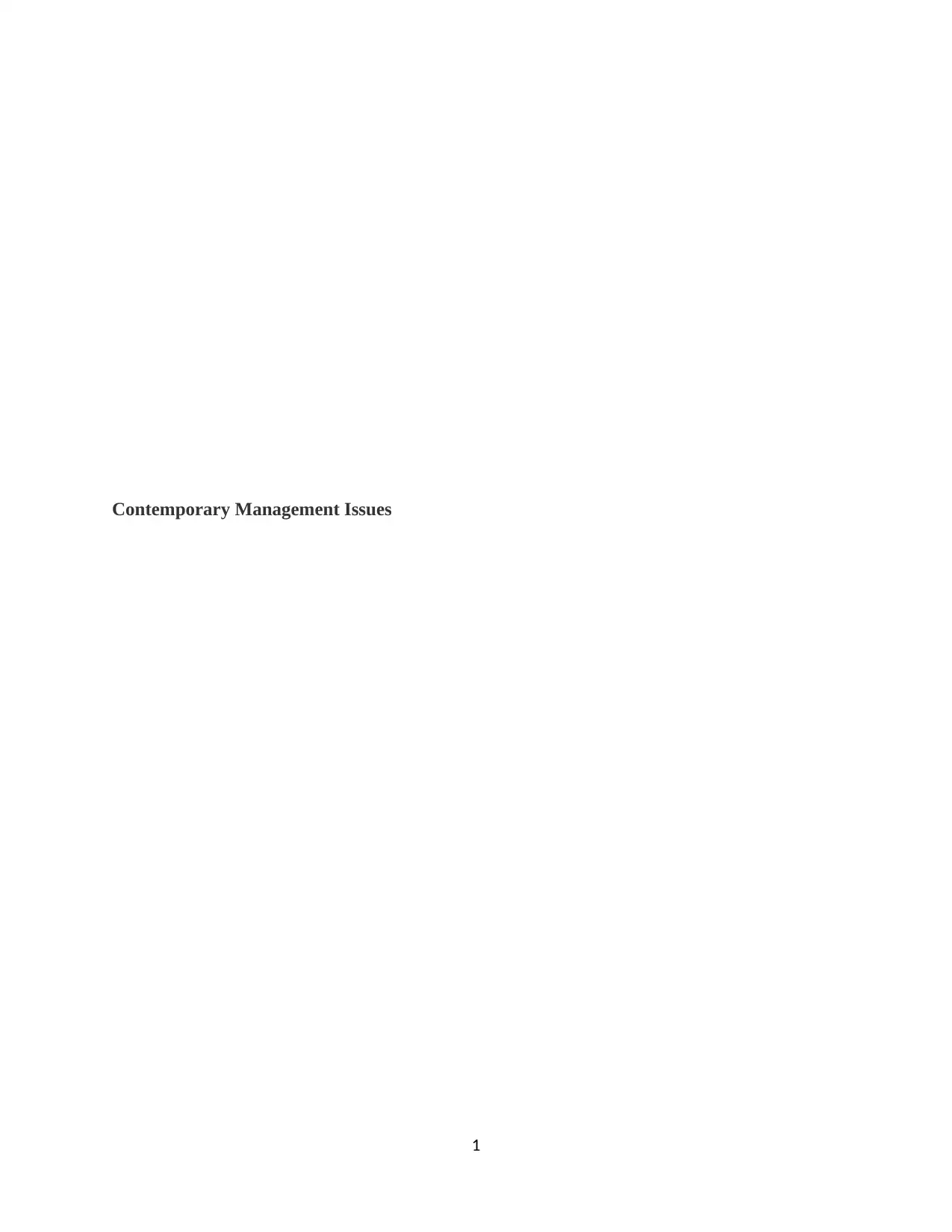
Contemporary Management Issues
1
1
Paraphrase This Document
Need a fresh take? Get an instant paraphrase of this document with our AI Paraphraser
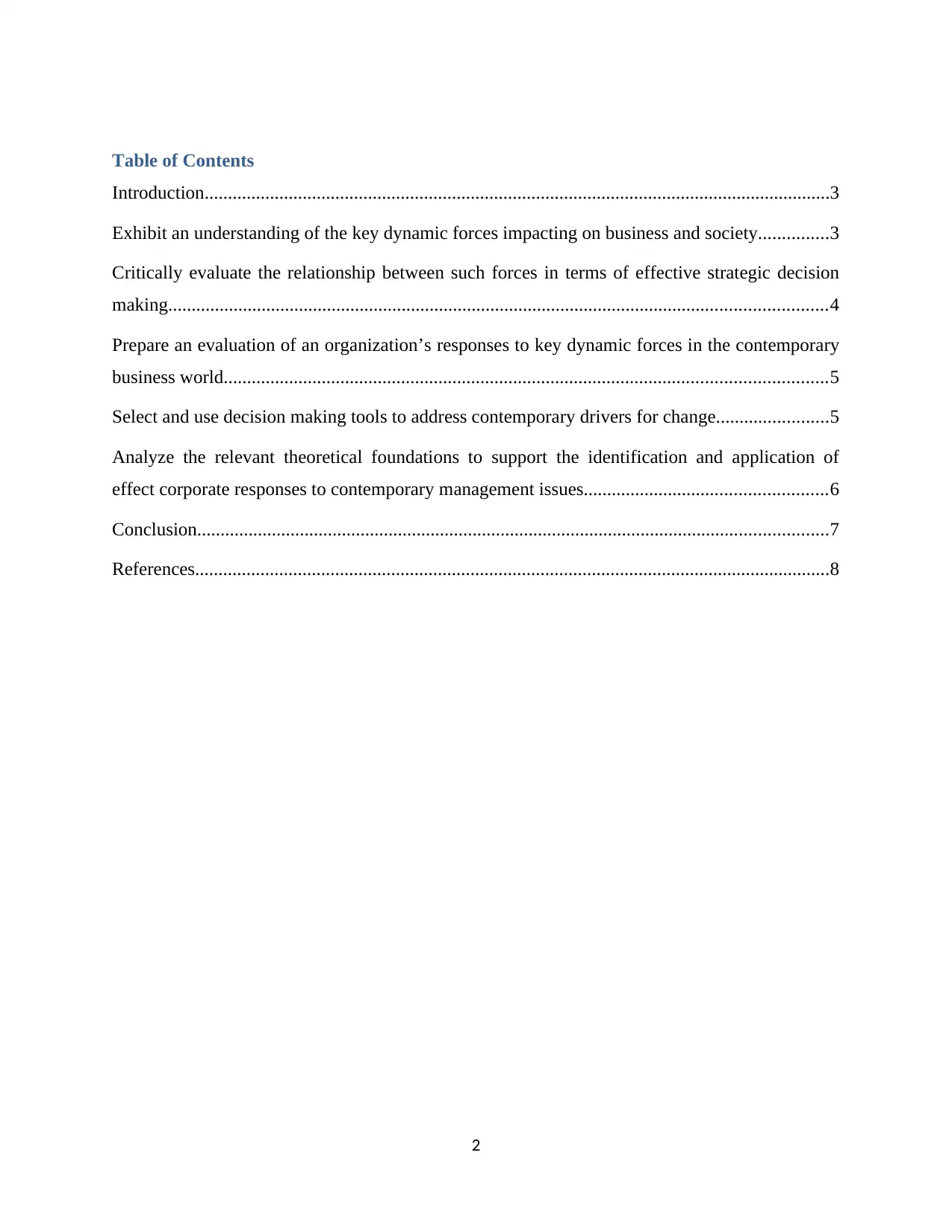
Table of Contents
Introduction......................................................................................................................................3
Exhibit an understanding of the key dynamic forces impacting on business and society...............3
Critically evaluate the relationship between such forces in terms of effective strategic decision
making.............................................................................................................................................4
Prepare an evaluation of an organization’s responses to key dynamic forces in the contemporary
business world.................................................................................................................................5
Select and use decision making tools to address contemporary drivers for change........................5
Analyze the relevant theoretical foundations to support the identification and application of
effect corporate responses to contemporary management issues....................................................6
Conclusion.......................................................................................................................................7
References........................................................................................................................................8
2
Introduction......................................................................................................................................3
Exhibit an understanding of the key dynamic forces impacting on business and society...............3
Critically evaluate the relationship between such forces in terms of effective strategic decision
making.............................................................................................................................................4
Prepare an evaluation of an organization’s responses to key dynamic forces in the contemporary
business world.................................................................................................................................5
Select and use decision making tools to address contemporary drivers for change........................5
Analyze the relevant theoretical foundations to support the identification and application of
effect corporate responses to contemporary management issues....................................................6
Conclusion.......................................................................................................................................7
References........................................................................................................................................8
2
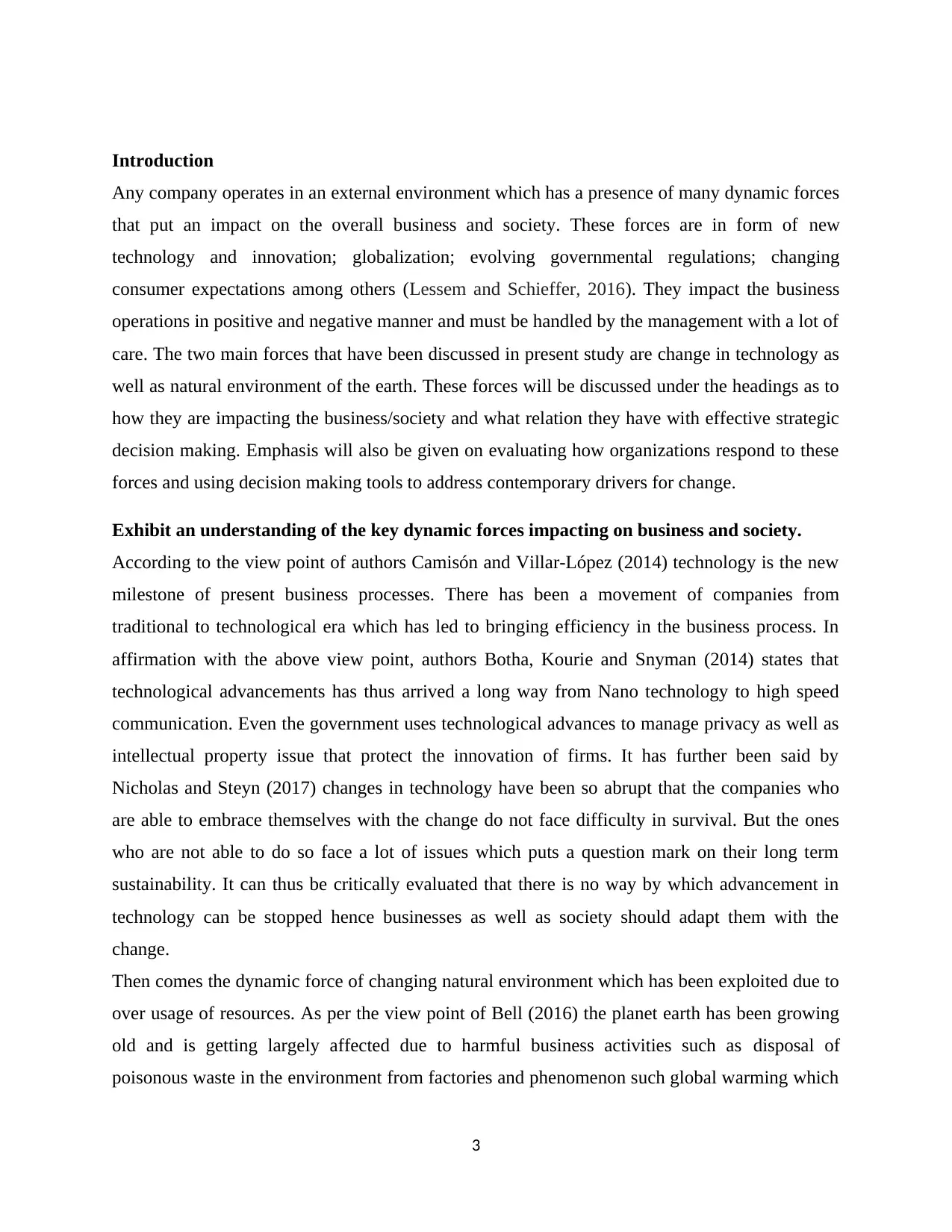
Introduction
Any company operates in an external environment which has a presence of many dynamic forces
that put an impact on the overall business and society. These forces are in form of new
technology and innovation; globalization; evolving governmental regulations; changing
consumer expectations among others (Lessem and Schieffer, 2016). They impact the business
operations in positive and negative manner and must be handled by the management with a lot of
care. The two main forces that have been discussed in present study are change in technology as
well as natural environment of the earth. These forces will be discussed under the headings as to
how they are impacting the business/society and what relation they have with effective strategic
decision making. Emphasis will also be given on evaluating how organizations respond to these
forces and using decision making tools to address contemporary drivers for change.
Exhibit an understanding of the key dynamic forces impacting on business and society.
According to the view point of authors Camisón and Villar-López (2014) technology is the new
milestone of present business processes. There has been a movement of companies from
traditional to technological era which has led to bringing efficiency in the business process. In
affirmation with the above view point, authors Botha, Kourie and Snyman (2014) states that
technological advancements has thus arrived a long way from Nano technology to high speed
communication. Even the government uses technological advances to manage privacy as well as
intellectual property issue that protect the innovation of firms. It has further been said by
Nicholas and Steyn (2017) changes in technology have been so abrupt that the companies who
are able to embrace themselves with the change do not face difficulty in survival. But the ones
who are not able to do so face a lot of issues which puts a question mark on their long term
sustainability. It can thus be critically evaluated that there is no way by which advancement in
technology can be stopped hence businesses as well as society should adapt them with the
change.
Then comes the dynamic force of changing natural environment which has been exploited due to
over usage of resources. As per the view point of Bell (2016) the planet earth has been growing
old and is getting largely affected due to harmful business activities such as disposal of
poisonous waste in the environment from factories and phenomenon such global warming which
3
Any company operates in an external environment which has a presence of many dynamic forces
that put an impact on the overall business and society. These forces are in form of new
technology and innovation; globalization; evolving governmental regulations; changing
consumer expectations among others (Lessem and Schieffer, 2016). They impact the business
operations in positive and negative manner and must be handled by the management with a lot of
care. The two main forces that have been discussed in present study are change in technology as
well as natural environment of the earth. These forces will be discussed under the headings as to
how they are impacting the business/society and what relation they have with effective strategic
decision making. Emphasis will also be given on evaluating how organizations respond to these
forces and using decision making tools to address contemporary drivers for change.
Exhibit an understanding of the key dynamic forces impacting on business and society.
According to the view point of authors Camisón and Villar-López (2014) technology is the new
milestone of present business processes. There has been a movement of companies from
traditional to technological era which has led to bringing efficiency in the business process. In
affirmation with the above view point, authors Botha, Kourie and Snyman (2014) states that
technological advancements has thus arrived a long way from Nano technology to high speed
communication. Even the government uses technological advances to manage privacy as well as
intellectual property issue that protect the innovation of firms. It has further been said by
Nicholas and Steyn (2017) changes in technology have been so abrupt that the companies who
are able to embrace themselves with the change do not face difficulty in survival. But the ones
who are not able to do so face a lot of issues which puts a question mark on their long term
sustainability. It can thus be critically evaluated that there is no way by which advancement in
technology can be stopped hence businesses as well as society should adapt them with the
change.
Then comes the dynamic force of changing natural environment which has been exploited due to
over usage of resources. As per the view point of Bell (2016) the planet earth has been growing
old and is getting largely affected due to harmful business activities such as disposal of
poisonous waste in the environment from factories and phenomenon such global warming which
3
⊘ This is a preview!⊘
Do you want full access?
Subscribe today to unlock all pages.

Trusted by 1+ million students worldwide
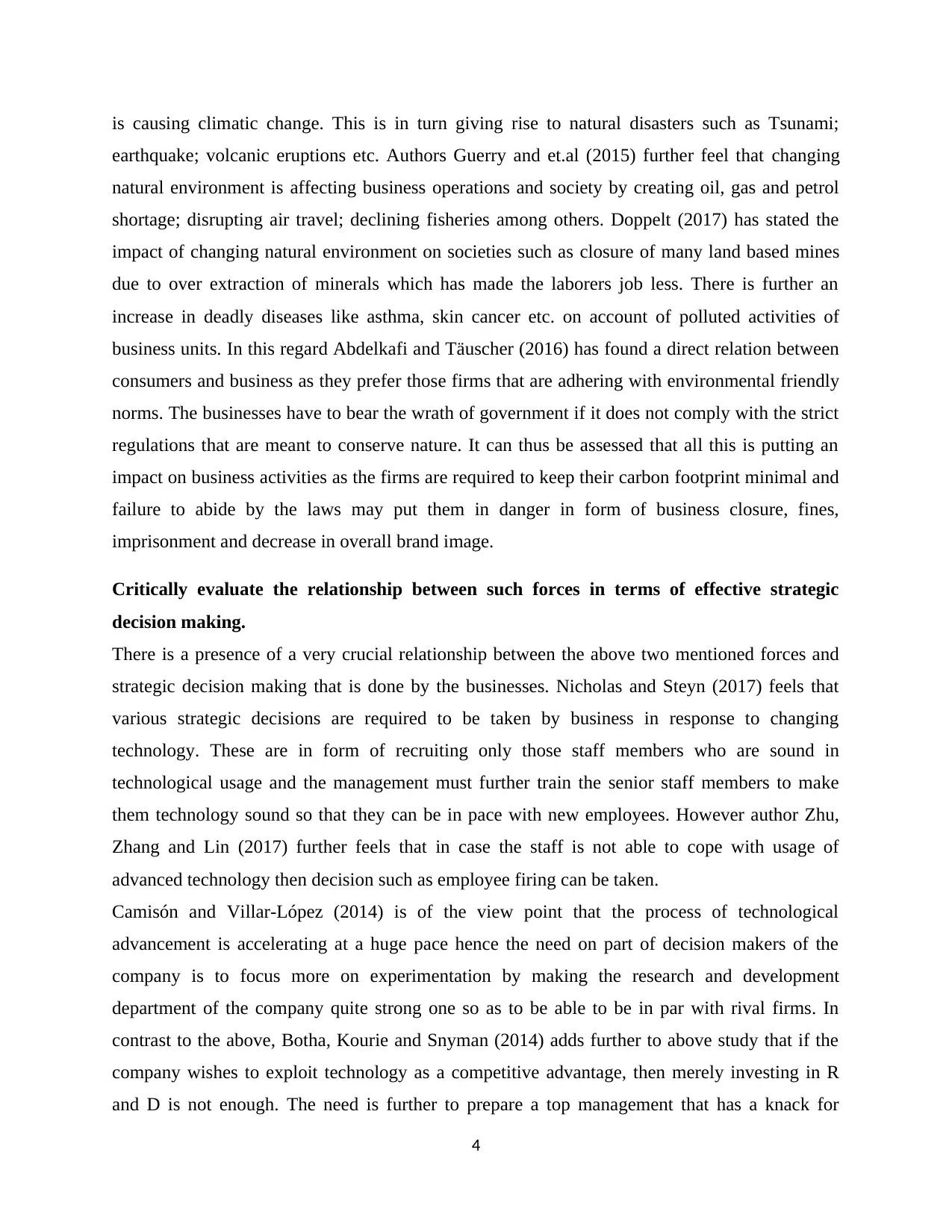
is causing climatic change. This is in turn giving rise to natural disasters such as Tsunami;
earthquake; volcanic eruptions etc. Authors Guerry and et.al (2015) further feel that changing
natural environment is affecting business operations and society by creating oil, gas and petrol
shortage; disrupting air travel; declining fisheries among others. Doppelt (2017) has stated the
impact of changing natural environment on societies such as closure of many land based mines
due to over extraction of minerals which has made the laborers job less. There is further an
increase in deadly diseases like asthma, skin cancer etc. on account of polluted activities of
business units. In this regard Abdelkafi and Täuscher (2016) has found a direct relation between
consumers and business as they prefer those firms that are adhering with environmental friendly
norms. The businesses have to bear the wrath of government if it does not comply with the strict
regulations that are meant to conserve nature. It can thus be assessed that all this is putting an
impact on business activities as the firms are required to keep their carbon footprint minimal and
failure to abide by the laws may put them in danger in form of business closure, fines,
imprisonment and decrease in overall brand image.
Critically evaluate the relationship between such forces in terms of effective strategic
decision making.
There is a presence of a very crucial relationship between the above two mentioned forces and
strategic decision making that is done by the businesses. Nicholas and Steyn (2017) feels that
various strategic decisions are required to be taken by business in response to changing
technology. These are in form of recruiting only those staff members who are sound in
technological usage and the management must further train the senior staff members to make
them technology sound so that they can be in pace with new employees. However author Zhu,
Zhang and Lin (2017) further feels that in case the staff is not able to cope with usage of
advanced technology then decision such as employee firing can be taken.
Camisón and Villar-López (2014) is of the view point that the process of technological
advancement is accelerating at a huge pace hence the need on part of decision makers of the
company is to focus more on experimentation by making the research and development
department of the company quite strong one so as to be able to be in par with rival firms. In
contrast to the above, Botha, Kourie and Snyman (2014) adds further to above study that if the
company wishes to exploit technology as a competitive advantage, then merely investing in R
and D is not enough. The need is further to prepare a top management that has a knack for
4
earthquake; volcanic eruptions etc. Authors Guerry and et.al (2015) further feel that changing
natural environment is affecting business operations and society by creating oil, gas and petrol
shortage; disrupting air travel; declining fisheries among others. Doppelt (2017) has stated the
impact of changing natural environment on societies such as closure of many land based mines
due to over extraction of minerals which has made the laborers job less. There is further an
increase in deadly diseases like asthma, skin cancer etc. on account of polluted activities of
business units. In this regard Abdelkafi and Täuscher (2016) has found a direct relation between
consumers and business as they prefer those firms that are adhering with environmental friendly
norms. The businesses have to bear the wrath of government if it does not comply with the strict
regulations that are meant to conserve nature. It can thus be assessed that all this is putting an
impact on business activities as the firms are required to keep their carbon footprint minimal and
failure to abide by the laws may put them in danger in form of business closure, fines,
imprisonment and decrease in overall brand image.
Critically evaluate the relationship between such forces in terms of effective strategic
decision making.
There is a presence of a very crucial relationship between the above two mentioned forces and
strategic decision making that is done by the businesses. Nicholas and Steyn (2017) feels that
various strategic decisions are required to be taken by business in response to changing
technology. These are in form of recruiting only those staff members who are sound in
technological usage and the management must further train the senior staff members to make
them technology sound so that they can be in pace with new employees. However author Zhu,
Zhang and Lin (2017) further feels that in case the staff is not able to cope with usage of
advanced technology then decision such as employee firing can be taken.
Camisón and Villar-López (2014) is of the view point that the process of technological
advancement is accelerating at a huge pace hence the need on part of decision makers of the
company is to focus more on experimentation by making the research and development
department of the company quite strong one so as to be able to be in par with rival firms. In
contrast to the above, Botha, Kourie and Snyman (2014) adds further to above study that if the
company wishes to exploit technology as a competitive advantage, then merely investing in R
and D is not enough. The need is further to prepare a top management that has a knack for
4
Paraphrase This Document
Need a fresh take? Get an instant paraphrase of this document with our AI Paraphraser
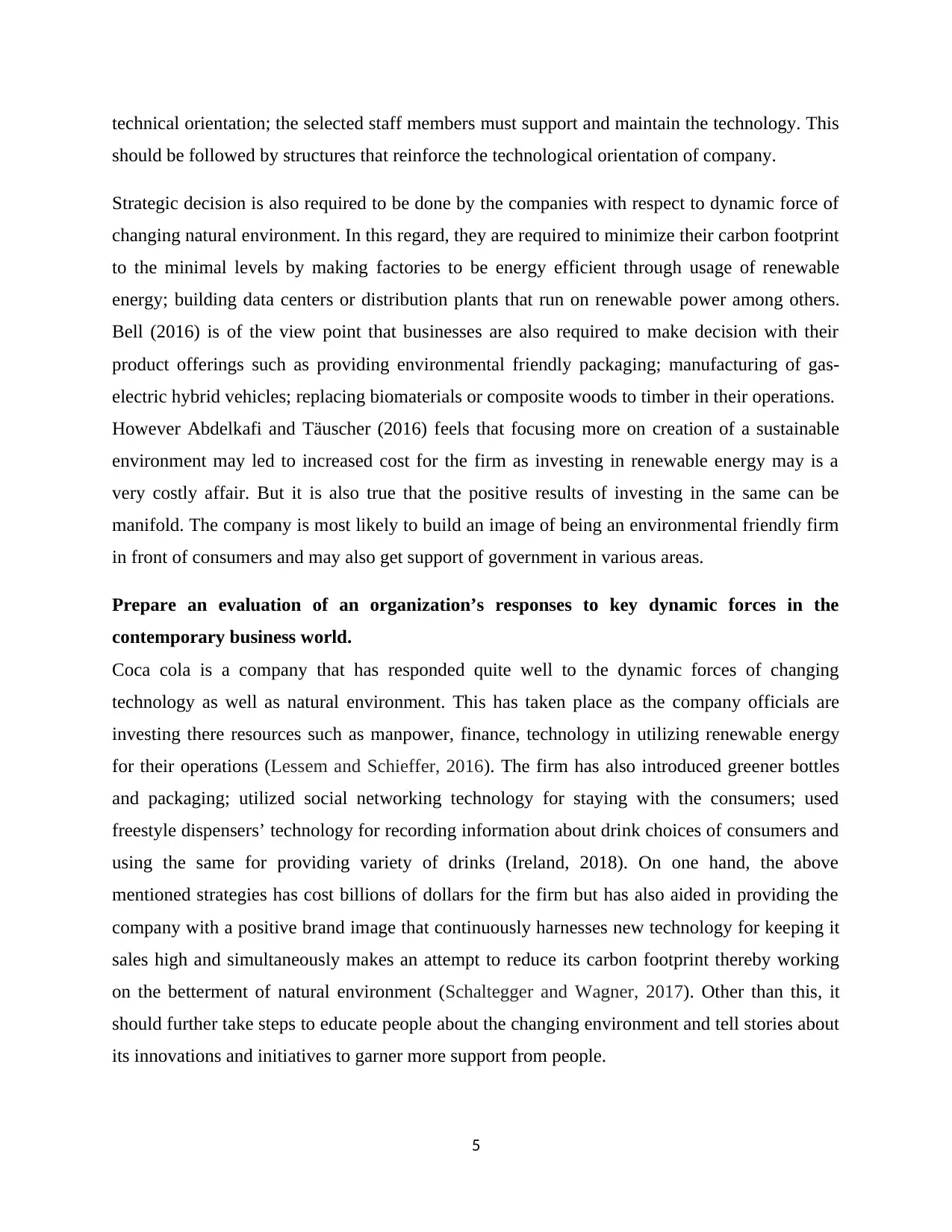
technical orientation; the selected staff members must support and maintain the technology. This
should be followed by structures that reinforce the technological orientation of company.
Strategic decision is also required to be done by the companies with respect to dynamic force of
changing natural environment. In this regard, they are required to minimize their carbon footprint
to the minimal levels by making factories to be energy efficient through usage of renewable
energy; building data centers or distribution plants that run on renewable power among others.
Bell (2016) is of the view point that businesses are also required to make decision with their
product offerings such as providing environmental friendly packaging; manufacturing of gas-
electric hybrid vehicles; replacing biomaterials or composite woods to timber in their operations.
However Abdelkafi and Täuscher (2016) feels that focusing more on creation of a sustainable
environment may led to increased cost for the firm as investing in renewable energy may is a
very costly affair. But it is also true that the positive results of investing in the same can be
manifold. The company is most likely to build an image of being an environmental friendly firm
in front of consumers and may also get support of government in various areas.
Prepare an evaluation of an organization’s responses to key dynamic forces in the
contemporary business world.
Coca cola is a company that has responded quite well to the dynamic forces of changing
technology as well as natural environment. This has taken place as the company officials are
investing there resources such as manpower, finance, technology in utilizing renewable energy
for their operations (Lessem and Schieffer, 2016). The firm has also introduced greener bottles
and packaging; utilized social networking technology for staying with the consumers; used
freestyle dispensers’ technology for recording information about drink choices of consumers and
using the same for providing variety of drinks (Ireland, 2018). On one hand, the above
mentioned strategies has cost billions of dollars for the firm but has also aided in providing the
company with a positive brand image that continuously harnesses new technology for keeping it
sales high and simultaneously makes an attempt to reduce its carbon footprint thereby working
on the betterment of natural environment (Schaltegger and Wagner, 2017). Other than this, it
should further take steps to educate people about the changing environment and tell stories about
its innovations and initiatives to garner more support from people.
5
should be followed by structures that reinforce the technological orientation of company.
Strategic decision is also required to be done by the companies with respect to dynamic force of
changing natural environment. In this regard, they are required to minimize their carbon footprint
to the minimal levels by making factories to be energy efficient through usage of renewable
energy; building data centers or distribution plants that run on renewable power among others.
Bell (2016) is of the view point that businesses are also required to make decision with their
product offerings such as providing environmental friendly packaging; manufacturing of gas-
electric hybrid vehicles; replacing biomaterials or composite woods to timber in their operations.
However Abdelkafi and Täuscher (2016) feels that focusing more on creation of a sustainable
environment may led to increased cost for the firm as investing in renewable energy may is a
very costly affair. But it is also true that the positive results of investing in the same can be
manifold. The company is most likely to build an image of being an environmental friendly firm
in front of consumers and may also get support of government in various areas.
Prepare an evaluation of an organization’s responses to key dynamic forces in the
contemporary business world.
Coca cola is a company that has responded quite well to the dynamic forces of changing
technology as well as natural environment. This has taken place as the company officials are
investing there resources such as manpower, finance, technology in utilizing renewable energy
for their operations (Lessem and Schieffer, 2016). The firm has also introduced greener bottles
and packaging; utilized social networking technology for staying with the consumers; used
freestyle dispensers’ technology for recording information about drink choices of consumers and
using the same for providing variety of drinks (Ireland, 2018). On one hand, the above
mentioned strategies has cost billions of dollars for the firm but has also aided in providing the
company with a positive brand image that continuously harnesses new technology for keeping it
sales high and simultaneously makes an attempt to reduce its carbon footprint thereby working
on the betterment of natural environment (Schaltegger and Wagner, 2017). Other than this, it
should further take steps to educate people about the changing environment and tell stories about
its innovations and initiatives to garner more support from people.
5
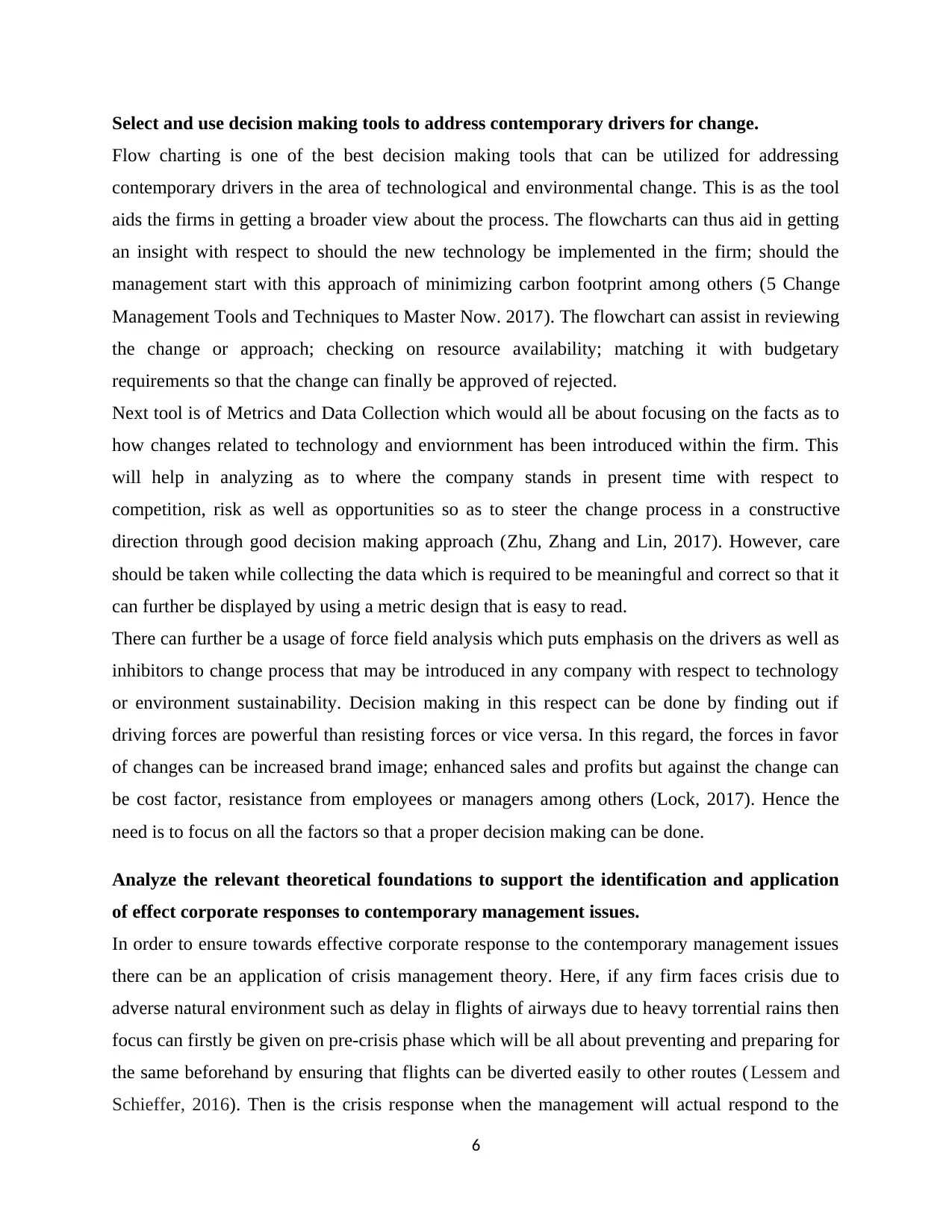
Select and use decision making tools to address contemporary drivers for change.
Flow charting is one of the best decision making tools that can be utilized for addressing
contemporary drivers in the area of technological and environmental change. This is as the tool
aids the firms in getting a broader view about the process. The flowcharts can thus aid in getting
an insight with respect to should the new technology be implemented in the firm; should the
management start with this approach of minimizing carbon footprint among others (5 Change
Management Tools and Techniques to Master Now. 2017). The flowchart can assist in reviewing
the change or approach; checking on resource availability; matching it with budgetary
requirements so that the change can finally be approved of rejected.
Next tool is of Metrics and Data Collection which would all be about focusing on the facts as to
how changes related to technology and enviornment has been introduced within the firm. This
will help in analyzing as to where the company stands in present time with respect to
competition, risk as well as opportunities so as to steer the change process in a constructive
direction through good decision making approach (Zhu, Zhang and Lin, 2017). However, care
should be taken while collecting the data which is required to be meaningful and correct so that it
can further be displayed by using a metric design that is easy to read.
There can further be a usage of force field analysis which puts emphasis on the drivers as well as
inhibitors to change process that may be introduced in any company with respect to technology
or environment sustainability. Decision making in this respect can be done by finding out if
driving forces are powerful than resisting forces or vice versa. In this regard, the forces in favor
of changes can be increased brand image; enhanced sales and profits but against the change can
be cost factor, resistance from employees or managers among others (Lock, 2017). Hence the
need is to focus on all the factors so that a proper decision making can be done.
Analyze the relevant theoretical foundations to support the identification and application
of effect corporate responses to contemporary management issues.
In order to ensure towards effective corporate response to the contemporary management issues
there can be an application of crisis management theory. Here, if any firm faces crisis due to
adverse natural environment such as delay in flights of airways due to heavy torrential rains then
focus can firstly be given on pre-crisis phase which will be all about preventing and preparing for
the same beforehand by ensuring that flights can be diverted easily to other routes (Lessem and
Schieffer, 2016). Then is the crisis response when the management will actual respond to the
6
Flow charting is one of the best decision making tools that can be utilized for addressing
contemporary drivers in the area of technological and environmental change. This is as the tool
aids the firms in getting a broader view about the process. The flowcharts can thus aid in getting
an insight with respect to should the new technology be implemented in the firm; should the
management start with this approach of minimizing carbon footprint among others (5 Change
Management Tools and Techniques to Master Now. 2017). The flowchart can assist in reviewing
the change or approach; checking on resource availability; matching it with budgetary
requirements so that the change can finally be approved of rejected.
Next tool is of Metrics and Data Collection which would all be about focusing on the facts as to
how changes related to technology and enviornment has been introduced within the firm. This
will help in analyzing as to where the company stands in present time with respect to
competition, risk as well as opportunities so as to steer the change process in a constructive
direction through good decision making approach (Zhu, Zhang and Lin, 2017). However, care
should be taken while collecting the data which is required to be meaningful and correct so that it
can further be displayed by using a metric design that is easy to read.
There can further be a usage of force field analysis which puts emphasis on the drivers as well as
inhibitors to change process that may be introduced in any company with respect to technology
or environment sustainability. Decision making in this respect can be done by finding out if
driving forces are powerful than resisting forces or vice versa. In this regard, the forces in favor
of changes can be increased brand image; enhanced sales and profits but against the change can
be cost factor, resistance from employees or managers among others (Lock, 2017). Hence the
need is to focus on all the factors so that a proper decision making can be done.
Analyze the relevant theoretical foundations to support the identification and application
of effect corporate responses to contemporary management issues.
In order to ensure towards effective corporate response to the contemporary management issues
there can be an application of crisis management theory. Here, if any firm faces crisis due to
adverse natural environment such as delay in flights of airways due to heavy torrential rains then
focus can firstly be given on pre-crisis phase which will be all about preventing and preparing for
the same beforehand by ensuring that flights can be diverted easily to other routes (Lessem and
Schieffer, 2016). Then is the crisis response when the management will actual respond to the
6
⊘ This is a preview!⊘
Do you want full access?
Subscribe today to unlock all pages.

Trusted by 1+ million students worldwide
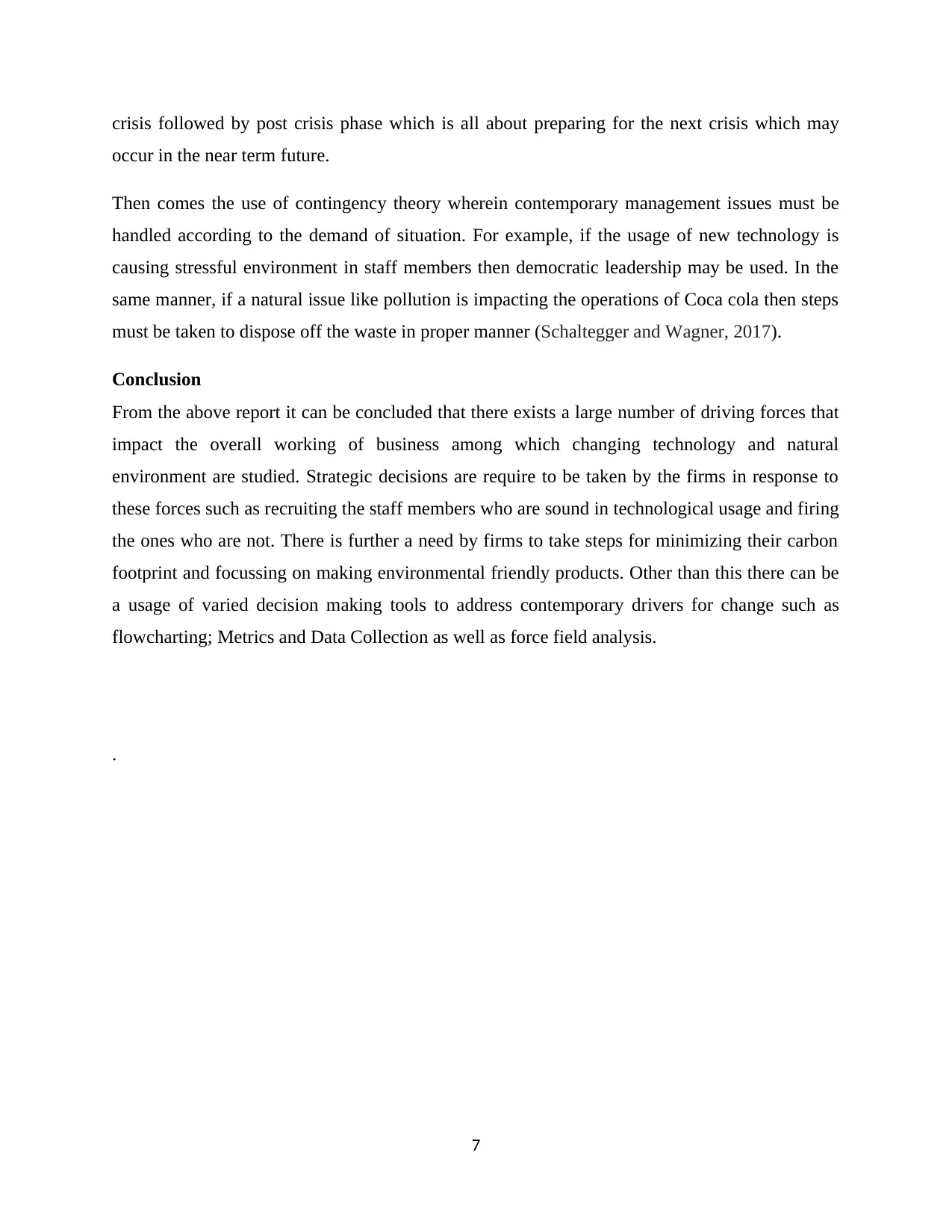
crisis followed by post crisis phase which is all about preparing for the next crisis which may
occur in the near term future.
Then comes the use of contingency theory wherein contemporary management issues must be
handled according to the demand of situation. For example, if the usage of new technology is
causing stressful environment in staff members then democratic leadership may be used. In the
same manner, if a natural issue like pollution is impacting the operations of Coca cola then steps
must be taken to dispose off the waste in proper manner (Schaltegger and Wagner, 2017).
Conclusion
From the above report it can be concluded that there exists a large number of driving forces that
impact the overall working of business among which changing technology and natural
environment are studied. Strategic decisions are require to be taken by the firms in response to
these forces such as recruiting the staff members who are sound in technological usage and firing
the ones who are not. There is further a need by firms to take steps for minimizing their carbon
footprint and focussing on making environmental friendly products. Other than this there can be
a usage of varied decision making tools to address contemporary drivers for change such as
flowcharting; Metrics and Data Collection as well as force field analysis.
.
7
occur in the near term future.
Then comes the use of contingency theory wherein contemporary management issues must be
handled according to the demand of situation. For example, if the usage of new technology is
causing stressful environment in staff members then democratic leadership may be used. In the
same manner, if a natural issue like pollution is impacting the operations of Coca cola then steps
must be taken to dispose off the waste in proper manner (Schaltegger and Wagner, 2017).
Conclusion
From the above report it can be concluded that there exists a large number of driving forces that
impact the overall working of business among which changing technology and natural
environment are studied. Strategic decisions are require to be taken by the firms in response to
these forces such as recruiting the staff members who are sound in technological usage and firing
the ones who are not. There is further a need by firms to take steps for minimizing their carbon
footprint and focussing on making environmental friendly products. Other than this there can be
a usage of varied decision making tools to address contemporary drivers for change such as
flowcharting; Metrics and Data Collection as well as force field analysis.
.
7
Paraphrase This Document
Need a fresh take? Get an instant paraphrase of this document with our AI Paraphraser
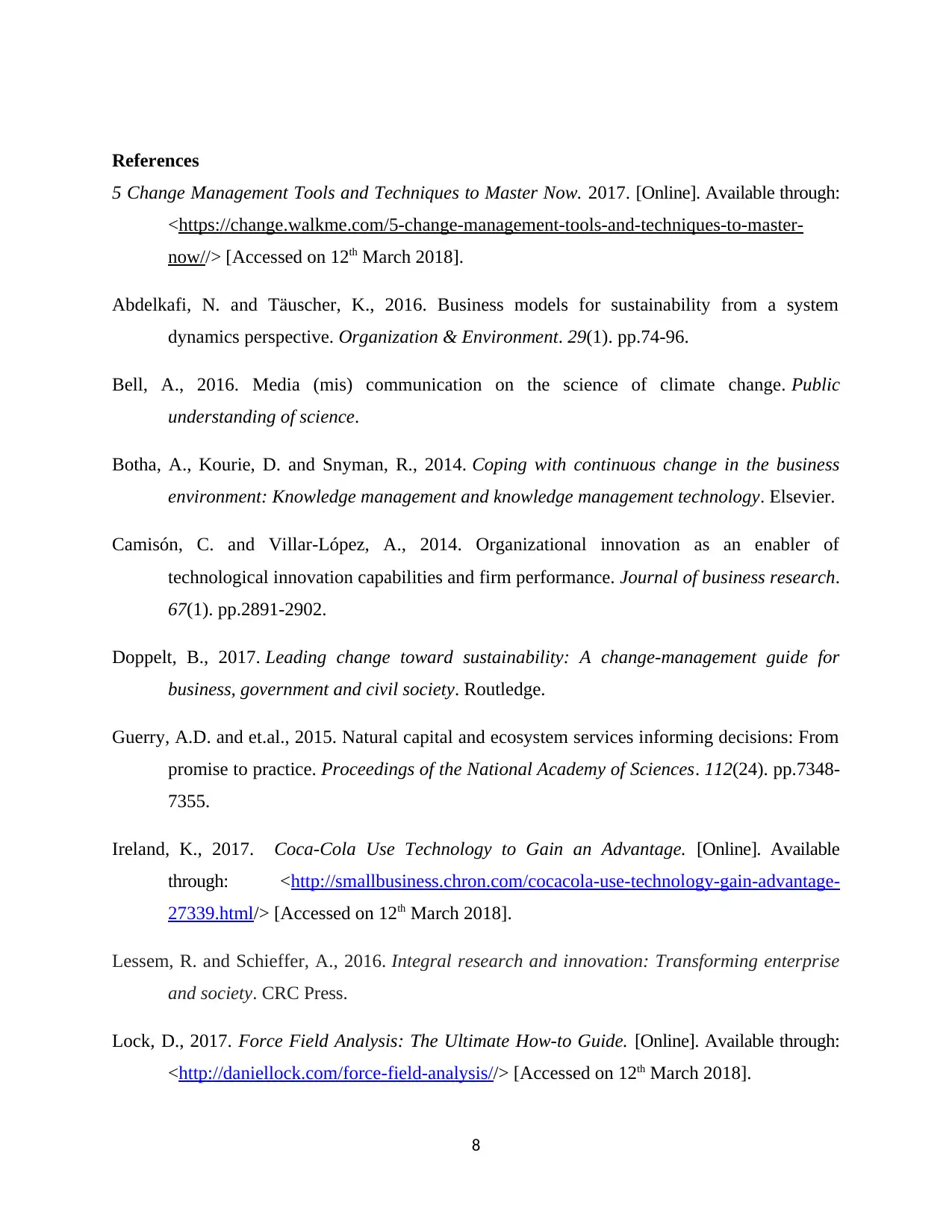
References
5 Change Management Tools and Techniques to Master Now. 2017. [Online]. Available through:
<https://change.walkme.com/5-change-management-tools-and-techniques-to-master-
now//> [Accessed on 12th March 2018].
Abdelkafi, N. and Täuscher, K., 2016. Business models for sustainability from a system
dynamics perspective. Organization & Environment. 29(1). pp.74-96.
Bell, A., 2016. Media (mis) communication on the science of climate change. Public
understanding of science.
Botha, A., Kourie, D. and Snyman, R., 2014. Coping with continuous change in the business
environment: Knowledge management and knowledge management technology. Elsevier.
Camisón, C. and Villar-López, A., 2014. Organizational innovation as an enabler of
technological innovation capabilities and firm performance. Journal of business research.
67(1). pp.2891-2902.
Doppelt, B., 2017. Leading change toward sustainability: A change-management guide for
business, government and civil society. Routledge.
Guerry, A.D. and et.al., 2015. Natural capital and ecosystem services informing decisions: From
promise to practice. Proceedings of the National Academy of Sciences. 112(24). pp.7348-
7355.
Ireland, K., 2017. Coca-Cola Use Technology to Gain an Advantage. [Online]. Available
through: <http://smallbusiness.chron.com/cocacola-use-technology-gain-advantage-
27339.html/> [Accessed on 12th March 2018].
Lessem, R. and Schieffer, A., 2016. Integral research and innovation: Transforming enterprise
and society. CRC Press.
Lock, D., 2017. Force Field Analysis: The Ultimate How-to Guide. [Online]. Available through:
<http://daniellock.com/force-field-analysis//> [Accessed on 12th March 2018].
8
5 Change Management Tools and Techniques to Master Now. 2017. [Online]. Available through:
<https://change.walkme.com/5-change-management-tools-and-techniques-to-master-
now//> [Accessed on 12th March 2018].
Abdelkafi, N. and Täuscher, K., 2016. Business models for sustainability from a system
dynamics perspective. Organization & Environment. 29(1). pp.74-96.
Bell, A., 2016. Media (mis) communication on the science of climate change. Public
understanding of science.
Botha, A., Kourie, D. and Snyman, R., 2014. Coping with continuous change in the business
environment: Knowledge management and knowledge management technology. Elsevier.
Camisón, C. and Villar-López, A., 2014. Organizational innovation as an enabler of
technological innovation capabilities and firm performance. Journal of business research.
67(1). pp.2891-2902.
Doppelt, B., 2017. Leading change toward sustainability: A change-management guide for
business, government and civil society. Routledge.
Guerry, A.D. and et.al., 2015. Natural capital and ecosystem services informing decisions: From
promise to practice. Proceedings of the National Academy of Sciences. 112(24). pp.7348-
7355.
Ireland, K., 2017. Coca-Cola Use Technology to Gain an Advantage. [Online]. Available
through: <http://smallbusiness.chron.com/cocacola-use-technology-gain-advantage-
27339.html/> [Accessed on 12th March 2018].
Lessem, R. and Schieffer, A., 2016. Integral research and innovation: Transforming enterprise
and society. CRC Press.
Lock, D., 2017. Force Field Analysis: The Ultimate How-to Guide. [Online]. Available through:
<http://daniellock.com/force-field-analysis//> [Accessed on 12th March 2018].
8
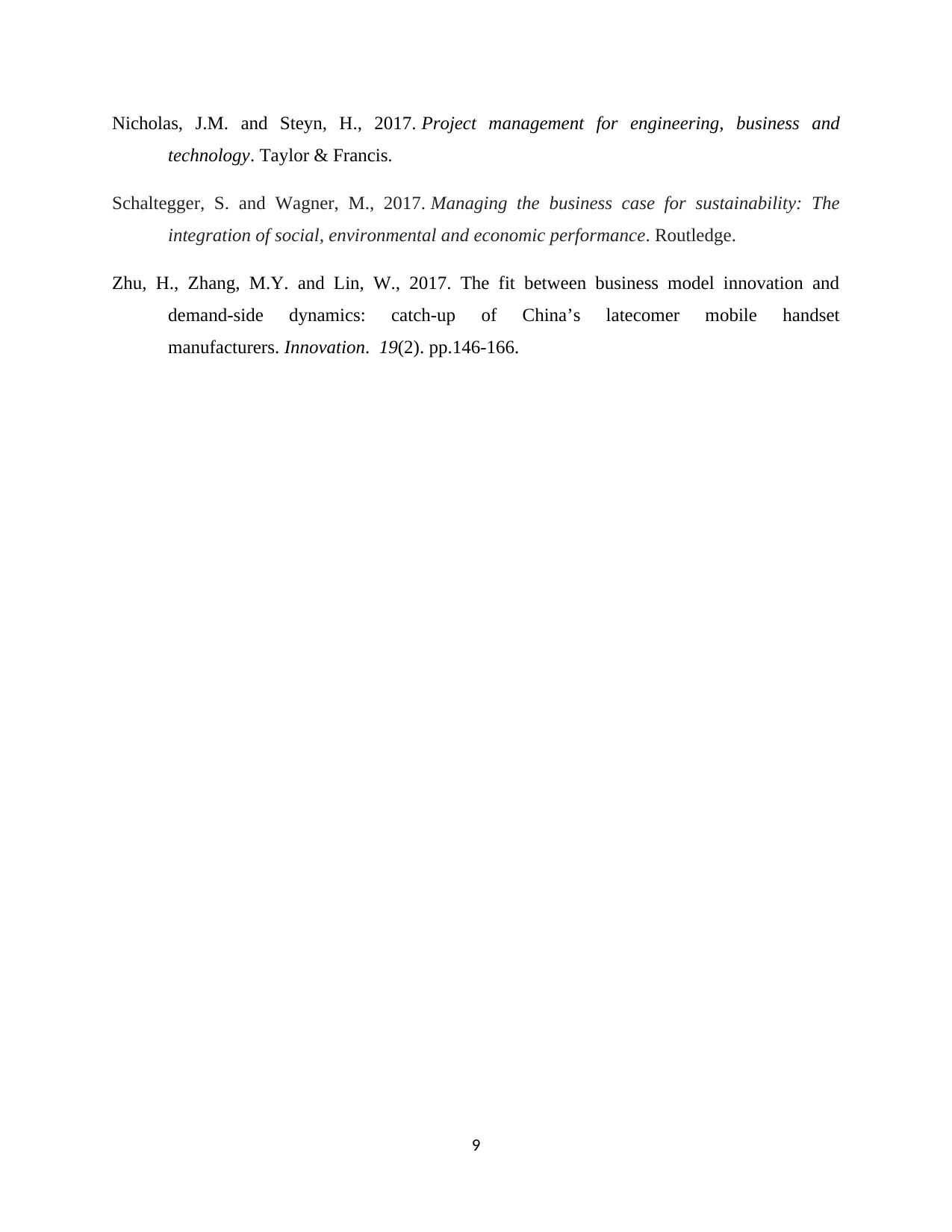
Nicholas, J.M. and Steyn, H., 2017. Project management for engineering, business and
technology. Taylor & Francis.
Schaltegger, S. and Wagner, M., 2017. Managing the business case for sustainability: The
integration of social, environmental and economic performance. Routledge.
Zhu, H., Zhang, M.Y. and Lin, W., 2017. The fit between business model innovation and
demand-side dynamics: catch-up of China’s latecomer mobile handset
manufacturers. Innovation. 19(2). pp.146-166.
9
technology. Taylor & Francis.
Schaltegger, S. and Wagner, M., 2017. Managing the business case for sustainability: The
integration of social, environmental and economic performance. Routledge.
Zhu, H., Zhang, M.Y. and Lin, W., 2017. The fit between business model innovation and
demand-side dynamics: catch-up of China’s latecomer mobile handset
manufacturers. Innovation. 19(2). pp.146-166.
9
⊘ This is a preview!⊘
Do you want full access?
Subscribe today to unlock all pages.

Trusted by 1+ million students worldwide
1 out of 9
Related Documents
Your All-in-One AI-Powered Toolkit for Academic Success.
+13062052269
info@desklib.com
Available 24*7 on WhatsApp / Email
![[object Object]](/_next/static/media/star-bottom.7253800d.svg)
Unlock your academic potential
Copyright © 2020–2025 A2Z Services. All Rights Reserved. Developed and managed by ZUCOL.





